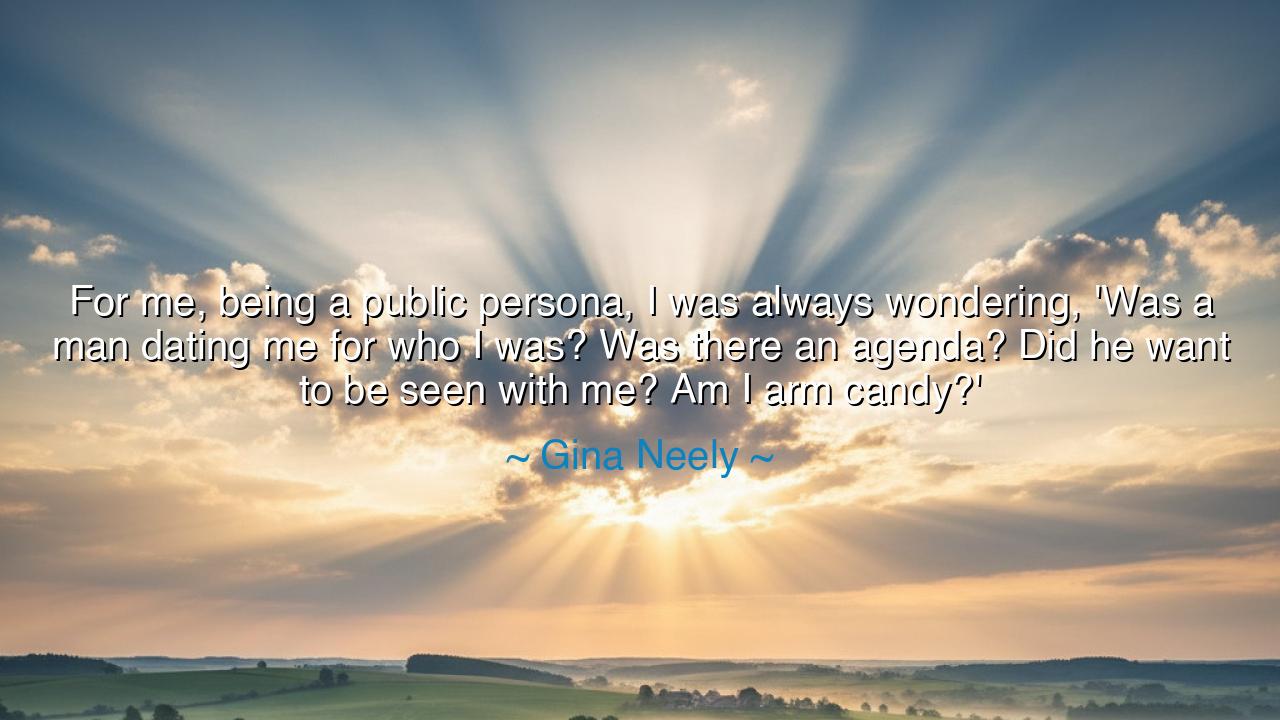
For me, being a public persona, I was always wondering, 'Was a
For me, being a public persona, I was always wondering, 'Was a man dating me for who I was? Was there an agenda? Did he want to be seen with me? Am I arm candy?'






In the marketplace of faces where fame is a kind of currency, a woman speaks the private riddle of public life: “For me, being a public persona, I was always wondering, ‘Was a man dating me for who I was? Was there an agenda? Did he want to be seen with me? Am I arm candy?’ ” So says Gina Neely, and her words fall like coins upon a temple floor, ringing with suspicion and ache. The saying names the ancient tension between person and mask, self and spectacle. It is the sorrow of being cherished for the shine and not the flame, for the silhouette and not the marrow. In such a world, every smile is a question, and every question is a guard at the gate of the heart.
The meaning is twofold. First, public persona is not a self; it is a garment stitched from lights, angles, and stories told about you rather than by you. Second, dating becomes a trial by mirror: does he see the woman, or merely the reflection of himself at her side? Agenda is the rust that eats trust from within; the will to be seen together can turn affection into advertisement. To be asked to play arm candy is to be offered a throne with no voice, a place that is high and hollow. Thus the vigilance in Neely’s line is not vanity; it is self-preservation.
The origin of this vigilance is the theater of fame itself. Visibility multiplies suitors and motives alike. Where ordinary courtship asks, “Do we fit?”, celebrity courtship must ask, “Do you love the seam or the fabric?” Neely’s refrain—who I was, agenda, be seen, arm candy—is the catechism of anyone whose name travels faster than their character. In such terrain, tenderness must be tested, and testing must be gentle but unflinching: a sieve fine enough to keep the gold and let the glitter pass.
Set beside her words a tale from the annals of bright faces and brighter minds. Hedy Lamarr, hailed as a star, was treated as ornament—escorted, exhibited, admired for her profile while her mind plotted frequencies and solved problems of war. Many men sought the glow; few stayed for the thinking fire. She co-created frequency-hopping spread spectrum, a seed of modern wireless, yet was often invited to banquets as arm candy rather than as architect. The world’s appetite to be seen with her obscured its duty to see her. Her story answers Neely’s questions with a caution: the feast of attention can starve the soul when it is not fed by recognition of the true person.
There is also the humbler parable that repeats across neighborhoods. A woman builds a small kingdom of craft and kindness, and suddenly companions appear who love the invitations more than the hostess, the table more than the cook, the lens more than the life. She learns, as Neely learned, to ask the quiet interrogations: Do you call when there is no crowd? Do you praise what costs me, not only what flatters you? Will you carry the bowl as eagerly as you carry the photograph? Such questions, asked early, spare later grief.
What, then, is the lesson to pass to daughters and sons who walk among spotlights and shadows? First, guard the difference between the public persona and the person; let the mask serve the face, never the face the mask. Second, test for agenda by inviting obscurity: choose places where there is nothing to be seen except each other’s patience and truth. Third, remember that love is not a platform but a practice; it is built by unfilmed errands, unposted kindness, unmarketed loyalty. When in doubt, ask: “If the cameras fell dark, would you still knock at my door?”
Take these practices as provisions for the road. Set a liturgy of small, private moments where fame cannot purchase entry. Ask suitors for help that offers no stage—hospital visits, long drives, chores that leave hands dirty and reputations untouched. Speak plainly of boundaries: “I will not be arm candy; I will be a partner.” Keep a counsel of elders who remember who you are before the world named you. And give thanks, loudly, for those who love you in the unlit hours; gratitude is the hedge that keeps counterfeiters at bay.
In the end, Neely’s sentence is both warning and benediction. It warns that the glimmer of public life attracts moths with hidden agendas. It blesses the search for the one who loves the ember, not the glow. If we hold to this wisdom, we will teach our hearts to prefer the steady hand to the spectacular entrance, the quiet keeper to the noisy claimant. And then, when someone asks us if we are loved, we may answer without fear: yes—not for the poster, but for the person; not as arm candy, but as a soul met and honored, wholly, as we are.






AAdministratorAdministrator
Welcome, honored guests. Please leave a comment, we will respond soon